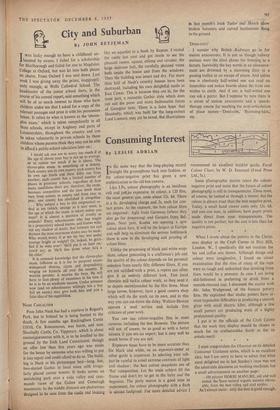City and Suburban
By JOHN BETJEMAN to afford'a public-school education later on: I would ask you not to worry too much if at the age of eleven your boy is not up to average, or to rejoice too much if he is above. The eleven-plus exam. is something of a lottery. Each county sets its own papers; each county has its own age limits and these differ one from another; each county has a limited number of places in grammar schools, regardless of how many candidates there are; therefore, the exam. becomes competitive and the pass mark must vary from county to county and from year to year; one county has abolished it altogether. . . Why'subject a boy to this enigmatical or- deal at ten (which, strange as it may seem, is the age at which the exam. is taken) unless you must? It is almost a question of cruelty to animals! Every schoolmaster who has taught in a preparatory school knows, and knows with- out any shadow of doubt, that between ten and thirteen the most enormous strides may be made. Who would worry if at ten his boy was under average height or weight? Or, indeed, be grati- fied if he were over? 'He'll put it on later on,' you'd say; or 'He'll fine down when he's a bit older.' It is common knowledge that the eleven-plus exam. (efficient as it is for its purpose) causes widespread distress, alarm and despondency, verging on hysteria all over the country. It worries parents: it worries the boys. He will have to face plenty of examiners in his time if he is to be an academic success. Undue pressure now (and no schoolmaster willingly lets a boy fail an exam.) may give both him and you a false idea of his capabilities.
NASH CASUALTIES
Poor John Nash has had a reprieve in Regent's Park, but in Ireland he is being hunted to the death: A few months ago Rockingham Castle (1810), Co. Roscommon, was burnt, and now Shanbally Castle, Co. Tipperary, which is about contemporaneous with it, is to be levelled to the ground by the Irish Land Commission, though an offer less than five years ago was made for the house by someone who was willing to put it into repair and could afford to do so. The build- ing is Nash at his picturesque best—long, loW, two-storied Gothic in local stone with irregu- larly placed corner towers. It looks across an undulating park over a wide valley and com- mands views of the Galtee and Comeragh mountains. In the middle distance are plantations designed to be seen from the castle and looking like an aquatint in a book by Repton. I 'visited the castle last year and got inside to see the pleasant rooms, square, oblong and circular, the large staircase hall, the carefully planned vistas both inside the house and from the windows. Then the building was intact and dry. Far more than half of Nash's country houses have been destroyed, including his own delightful castle at East Cowes. This is because they are in, for the most part, a romantic Gothic style which does not suit the purer and more fashionable forms of Georgian taste. There is a faint hope that Shanbally, which was built for the long-extinct Lord Lismore, may yet be saved. But illustrations in last month's Irish Taller and Sketch show broken balusters and carved battlements flung to the ground.
I wonder why British Railways go in for station announcers. It is not as though railway stations were the ideal places for listening to a lecture. Inevitably the key words in an announce- ment -are drowned by a slamming door or a passing trolley or an escape of steam. And unless one is absolutely half-witted one can read on timetables and notice boards about the train one wishes to catch. And if one is half-witted one can ask a porter. But I suppose by now there is a union of station announcers and a speech- therapy course for teaching the over-articulation of place names—`Deed-cdtt,"Byerming-ham: etc.














































 Previous page
Previous page